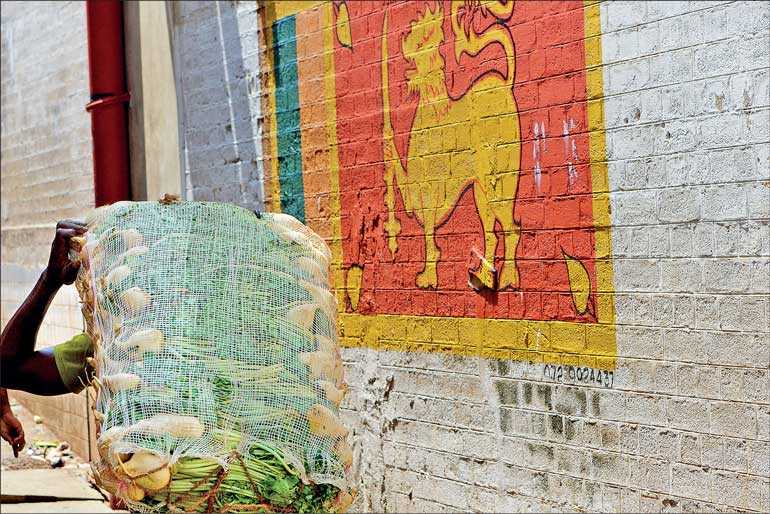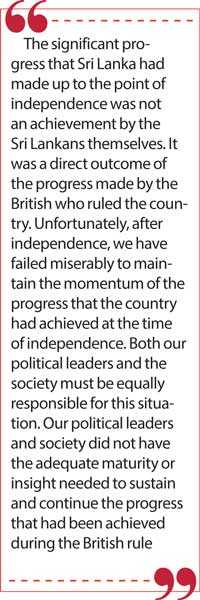Saturday Nov 01, 2025
Saturday Nov 01, 2025
Friday, 22 February 2019 00:15 - - {{hitsCtrl.values.hits}}

If Sri Lanka wants to get out of the present miserable situation, it needs to make a profound change, a paradigm  shift in the way it views at everything including the religious, political and economic issues. Such a change could be made only by looking insightfully at the question of what went wrong with Sri Lanka and finding the right answer to the question.
shift in the way it views at everything including the religious, political and economic issues. Such a change could be made only by looking insightfully at the question of what went wrong with Sri Lanka and finding the right answer to the question.
Collapse of progress
Sri Lanka remained a shining example among the other Asian countries by the time it gained independence from the British rule in 1948. It was second only to Japan in terms of per capita income. But, the gap between the two countries was not so big. Per capita income gap was very narrow. It excelled Japan in the indices of education and health enjoying number one position in their rankings.
Even in infrastructure facilities Sri Lanka had maintained a significant place. Though there were no carpeted roads like today, Sri Lanka was considered the country which had the best road network in Asia. It also had the best railway service in Asia. The Colombo harbour was acknowledged to be the best harbour in Asia. Sri Lanka had a sophisticated civil service composed mainly of career bureaucrats and a reputed Judiciary. The amount of foreign assets the country had at the time of independence was in excess of Rs. 1,200 million.
Despite all this, Sri Lanka had not been able to sustain the favourable conditions it inherited from the British. After independence, it has become a country headed for destruction rather than making progress. Some of the Asian nations which remained far behind Sri Lanka at the time when the latter gained independence had made an unprecedented progress. On the contrary, Sri Lanka, even after 71 years of independence, remains in an extremely miserable position.
The significant progress that Sri Lanka had made up to the point of independence was not an achievement by the Sri Lankans themselves. It was a direct outcome of the progress made by the British who ruled the country. Unfortunately, after independence, we have failed miserably to maintain the momentum of the progress that the country had achieved at the time of independence. Both our political leaders and the society must be equally responsible for this situation. Our political leaders and society did not have the adequate maturity or insight needed to sustain and continue the progress that had been achieved during the British rule.
Making the splendour of the ancient history, a protective shield
Sri Lanka can be described as a nation that had got accustomed to cover up its faults and weaknesses in a shield of the splendour of its ancient history. From a civilisational point of view, Sri Lanka had been a far more developed country than the British at one distant time in its past history. Interestingly, it was the British civil servants themselves who served in Sri Lanka made us aware of this fact. It was a lesson they taught us. Even that we have misunderstood and failed to grasp its meaning in its proper perspective.
In the journey of human history, a nation which had made major advances in one era can become a backward nation in another era. Babylonia, Egypt and Peru can be cited as examples for this phenomenon. Similarly, a nation which had remained backward in one era can become a progressive nation in another era. Great Britain is the best example that can be cited for this.
In this context, if a nation which has had a great splendour in the ancient history, but lingers in the backseat of the development process today points to an advance nation and tells them, “Hey, look here, we belonged to a great civilised nation in which our forefathers were clad in fine clothes by the time you people were living in jungles wearing leaves of trees,” it will be as good as an irrational and arrogant attempt to cover up its present failure as a nation. This can be considered the ugliest characteristic that one can witness in the anti-imperialistic attitude  prevails in Sri Lanka.
prevails in Sri Lanka.
It is a fact that Sri Lanka was a developed country when compared to Britain in one era of its long history. But, by the time Sri Lanka was subjugated by the British and taken control of it, they had made an exceptional progress which had been 100 times greater than the level of our country. It was this progress they had achieved, that, despite being a small country, the British were able not only to capture Sri Lanka, but also to build a large empire on which the sun never set.
I have read many books written by Sri Lankan scholars on the impact of colonialism in Sri Lanka. Except very few scholars like G.C. Mendis and Michael Roberts, all the others can be said to have attempted intentionally to cover up the backwardness that prevailed in the country by the time it was captured by the British, highlighting the ancient grandeur of the country.
Undoubtedly, the British exploited the resources of Sri Lanka and enjoyed the economic benefits after they captured it. But, the policy they adopted in respect of Sri Lanka cannot be considered to be totally rigid and predatory when compared to the policy they had followed in other countries of the British Empire, like India. It can be said that they had treated Sri Lanka more as an attractive holiday resort than a source worthy of plunder and exploitation.
Though they had acted ruthlessly in several instances, particularly in suppressing the rebellion of the 1818, they had effected relatively significant progress in the country by the time they left it. The changes that had come over Sri Lanka during the British rule were evidently poles apart when compared to the most backward conditions that prevailed in Sri Lanka when they captured it. Any study made on the British colonialism in Sri Lanka ignoring this fact cannot be considered a reasonable and objective analysis.
The positive aspects of colonialism
By the time the Kandyan kingdom was captured by the British, the society of its domain stood at a primitive level beset by extreme poverty and ignorance. The rate of infant mortality at birth and the rate of infanticide or intentional killing of infants for various reasons like economic hardships and credulous (astrological) beliefs remained high. The literacy rate too stood at a very low level.
According to Robert Knox, the Kandyan people did not have many possessions and “their houses are small, low, thatched cottages built with stick, daubed with clay; as to the furniture, their furniture is but small; a few earthen pots, a stool or two without backs, for none but the King may sit upon a stool with a back,” and a few basic implements for their cultivation, a few clothes barely adequate to cover the secret areas of the body. According to Knox, the people felt self-sufficient so long as they had adequate salt and rice. “Their diet and ordinary fare, if they have but rice and salt in their house they reckon they want for nothing.”
According to Knox, the people did not own lands. They tilled the lands belonged to the king, the queen, the temples, kovils, the nobility (radala) and the chieftains. This system obliged the tenant to perform services and duties, based on caste system. Among these obligations, there were some services which can be termed as mean and discriminatory.
Caste determined the entire lifestyle of the people. Their income, power, education, domicile, the area in which they lived , clothing, marriage and funeral rituals, customs and etiquettes, furniture and implements they used, their speech and articulation were all dependent on the caste system. There were certain community groups which were forbidden to cover the upper portion of the body and the areas below the knee.
The feudal service system linked with the land tenure constituted the serfdom structure of feudalism in Sri Lanka. The British abolished the feudal land tenure system of Sri Lanka to a greater extent, not in response to public agitations and revolts against the system as it happened in the medieval Europe, but by regulation and on their own accord. It was the British rulers and not the ancient kings of Sri Lanka who introduced the policy that recognised that all persons shall be equal before the law. It was they who introduced a system of modern schools and made the education an institution that embraced the whole society.
Intellectual poverty
The feudal system of production, the productive forces of that system which constituted the main elements of it and the relations in production process , production techniques and feudal institutions associated with it, were to a great extent wiped out or weakened by the British. In fact, these elements cannot be considered as entities which ought to have been preserved. Instead they deserved to be destroyed for the progress of the country and the benefit of the people.
The system of colonial capitalist production and its corresponding institution network introduced by the British can be considered a progressive move compared to the feudal system. However, after independence, Sri Lanka should have continued to use them only after effecting appropriate adjustments to suit the needs of the independent nation.
In this respect, India had a progressive vision. Sri Lanka did not have such a vision. While India had the systems it inherited from the British rule amended and reformed to suit the conditions of the independent India, Sri Lanka can be said to have pursued a different but an apathetic policy of using them as they were and without modifying them to suit the changing needs of the country.
This shows that there had been a significant difference between India and Sri Lanka in the way of their thinking. The protest movements launched for constitutional reforms in almost every country which were under colonial rule were usually preceded by religious revival movements. Compared to the religious revival movements of Hindus and Muslims in India, those of the Buddhists and Hindus in Sri Lanka can be considered as extremely backward movements.
In fact, The Hindu and Muslim Religious revival movements in India appeared for religious reconciliation and intra religious harmony. And they were concerned with the removal of outdated practices and rituals in their own faiths which were not compatible with the modern world and conducive to oppress the people. In doing so, they tried to give the religious ideology, a progressive orientation.
Raja Ram Mohan Roy, the leader of the Hindu Revival Movement in India and Syed Ahamed Khan, the leader of the Muslim Revival Movement in India were two erudite scholars who had grasped the true essence of the European renaissance movement in its proper perspective. They were adequately conversant with colonialism, capitalism and feudalism as well as the other religions and various other disciplines such as Science and Arts. They possessed a pragmatic and objective vision about religions.
But the situation of the Buddhist and Hindu revival movement in Sri Lanka was totally different from that of India. Both Anagarika Dharmapala who gave leadership to the Buddhist revival movement and Arumuga Navalar, the leader of the Hindu revival movement in Sri Lanka fought defiantly against the Catholic domination in the religious domain in the country. But they did not attempt to reform the outdated practices and rituals in their own faiths such caste discrimination. They cannot be considered as leaders who were concerned with the promotion of national harmony. Instead, their approach led more to create dissent and division among the people along the lines of race, religion and castes than to integrate them.
It was the strong caste differences that prevailed among the leading Buddhist priests that led Colonel Henry Steel Olcott, an American theosophist to be elected as the leader of the Buddhist revival movement in Sri Lanka. Olcott is honoured as one of the heroes and a pioneer of the religious, national and cultural revival in Sri Lanka. But it must also be mentioned here that no mention has been made in any one of the biographies written on Colonel Henry Steel Olcott as to why he had eventually left Sri Lanka with a firm resolution not to return again.
Founding of a new Nikaya or a sect of Buddhist Sangha and introducing a system of higher ordination for the bhikkus of non-Goyigama caste can be considered the most significant change effected by the Buddhist revival movement in Sri Lanka against the caste system that prevailed among the Buddhist priests and the monopoly enjoyed by the bhikkus of Goyigama caste in the sphere of conferring higher ordination for novice monks. This change eventually resulted in institutionalising the caste system within the order of the Buddhist Sangha rather than to abolish it. How sad it was to confine a great religion like Buddhism within a narrow frame of caste system which is contrary to the teachings of the Lord Buddha, the founder of Buddhism, who stood vehemently against the caste system.
A majority of the leaders of the temperance movement (except few leaders like Anagarika Dharmapala and Sir D.B. Jayatillaka) who played a predominant role in the Buddhist revival movement were leading liquor businessmen who had become rich by making fortunes by popularising liquor among the public.
Those interested in knowing more about this are advised to read two books written by me under the titles ‘The Tragic Plight of a Nation’ and ‘Revolt in the Temple’. The lack of proper appraisal of main issues of the country can be considered one of the most important factors influencing the parochialism of the present day thinking of Sri Lanka.
The independence movement of Sri Lanka
Anagarika Dharmapala and Arumuga Navalar can be described as the two thinkers who had influenced most in shaping the psyche of Sinhalese and Tamil people respectively. But the independence movement of Sri Lanka cannot be considered to have influenced the thinking of Sinhalese and Tamils. The independence movement of Sri Lanka did not have the leaders who can be deemed to be thinkers with a far-reaching vision.
Even though some of them who had pioneered the independence movement were educated in the universities in England, they cannot be considered to have been inspired by the thinking of eminent liberal philosophers of the calibre of John Locke, Charles Louis, Montesquieu, and John Stuart Mill. The representative principle which ought to have formed the basis of political reforms can be considered the biggest issue which had caused a dissent among the Sinhalese and Tamil leaders.
While the Sinhalese leaders appeared for a system of local representation for minority groups, the Tamil leaders insisted on equal representation for both the Sinhalese and Tamils. If the leaders of Sinhalese and Tamils had a sound understanding on liberal democratic principles, this issue could have been resolved without causing a rift between them and in a manner promoting mutual confidence and respect.
The biggest concern of the Tamil leaders was whether they would be oppressed by the Sinhalese if they get the majority power. This doubt appears to be the main factor that had led the Tamil leaders to insist on a system of equal representation for both communities. If, however, G.G. Ponnambalam had a proper understanding of the concept of liberalism, most probably, he could have demanded for a resolution that would safeguard the rights of the minority groups to be incorporated in the constitution rather than demanding for a system that provides 50% representation for the majority Sinhalese and the balance 50% for all other minority groups.
It is the lack of knowledge of both Sinhalese and Tamil leaders on democratic principles that can be deemed to be the main factor for not having a resolution on minority rights incorporated into the first Constitution, the Soulbury Constitution of Sri Lanka. This illustrates the extent of intellectual poverty of the then leaders of all communities who spearheaded the independence movement.
In the next article I intend to discuss the independence movement of Sri Lanka and the reasons that had brought down the country in to its present abyss thereafter.